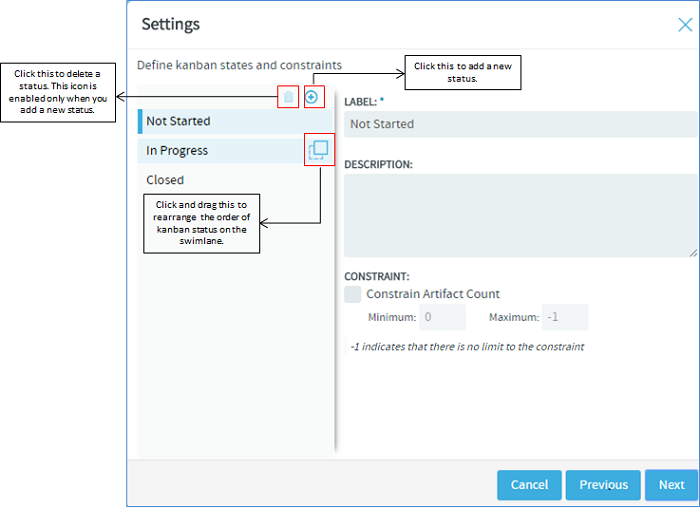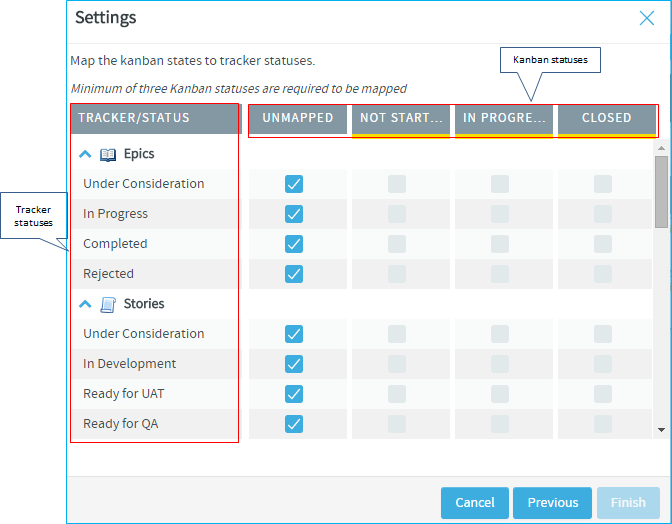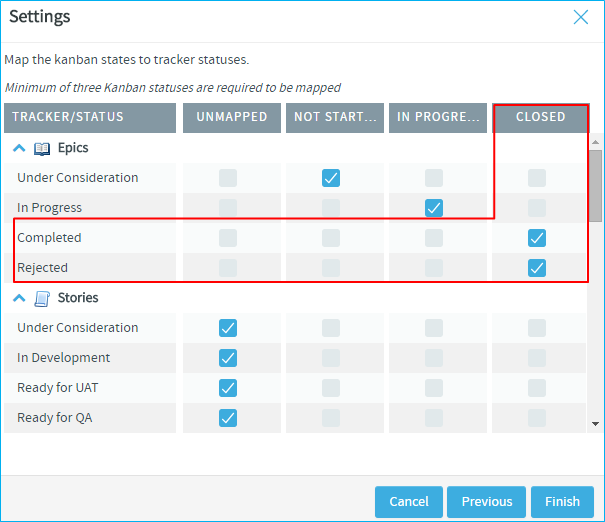As a project administrator, you can configure your Kanban Board based on your project
requirements.
Create Kanban Board states for the different stages of your project development
process, specify workflow constraints for each state and map them to your tracker
statuses.
-
Click TRACKERS from the Project
Home menu.
-
In the List Trackers, Planning Folders and Teams page,
click Kanban.
The following message is displayed prompting you to configure a Kanban
Board for the current project.
Kanban Board is not configured
for the project.
-
Click the Kanban Board configuration icon to open the
Settings window.

Note: Use the configuration icon when you create a Kanban
Board for the first time or when you want to modify the settings of your
current Kanban Board.
Alternatively, you can use Manage
Boards to create a new board.

For more
information about its usage, see Manage Boards.
-
Give a name to the new Kanban Board.
-
Select the trackers whose artifacts you want to view on your Kanban Board.
(These are the trackers you created for your project. For more information on
how to create a tracker, see Create a tracker.)
-
Click Next.
Kanban states and constraints
A kanban state is the status of a
work item in a value stream (swimlanes). The constraints or the limits that you
specify here dictates the behaviour of the board. These are checkpoints which
eventually help you track the progress of a work item, identify bottlenecks and
fix them. The default kanban statuses are 'Not Started', 'In Progress' and
'Closed'.
You can create your own kanban statuses, delete any state including the default one and rearrange
the order in which they would appear as swimlanes on your Kanban Board.
Note: If
there are only three kanban statuses, the Delete
Status icon is disabled disallowing you to delete any more
because you must maintain a minimum of three statuses.
-
Create and configure kanban statuses.
-
Click the Add Status icon. You can have a
maximum of 20 statuses.
-
Give a label and description to the new status.
Note: The kanban status label can have a maximum of 64 characters and
the description, a maximum of 256 characters. Alpha numeric and
special characters are allowed.
-
Select the Constrain Artifact Count check box to
specify the minimum and maximum workflow constraints, that is, specify
the minimum and maximum number of work items (artifact cards) that ought
to be present in each status. You may specify these values based on the
number of work items in the queue versus the number of resources
available.
Remember the following when you set the minimum or maximum value to
-1.
| Constraint value |
Logic |
Example |
|
Minimum value = -1
|
This is treated as zero. Therefore, though the
maximum value should be greater than the minimum
value, the following value range is allowed:
Minimum = -1
Maximum = 0 and above
|
Let us assume that you are in the last
iteration of your release. As a project manager,
you would not want to see any artifact in the
'Impeded' status. So you set the minimum to -1 and
maximum to 0, which translates to zero artifacts.
When this constraint is applied, your Kanban Board
flags a violation, if artifacts show up in the
'Impeded' status, thereby drawing your attention
to address the issue immediately.
|
|
Maximum value = -1
|
This indicates there is no limit to the maximum
value.
|
You may choose to set -1 as the maximum
constraint for the 'Closed' status because you
would want to see as many closed artifacts as
possible.
|
Important: These constraints are applicable only
at the planning folder level and not at the team level because
the Kanban Board is expected to give an overall visibility to
the work items for an iteration or release within a planning
folder and not just within a specific team.
Map kanban states with tracker status
Next, make a logical mapping
of the kanban states with the tracker statuses to view those tracker artifacts
on your Kanban Board. For example, to view defects, you must first make a
meaningful mapping of the kanban states with the defect tracker status(es). The
mapped kanban states appear as swimlanes on the Kanban Board.
The trackers
(you had selected in
Step
5) and their statuses appear on the left. All the kanban statuses
appear at the top. The tracker statuses are unmapped by default.
- You need to map a minimum of 3 kanban statuses.
- You can map a single kanban status to one or more tracker statuses, but
you cannot map a single tracker status to more than one kanban
status.
-
Click the appropriate check box. For example, for an Epic tracker, map
'Completed' and 'Rejected' tracker statuses with the Kanban statuses 'Closed' by
selecting the appropriate check boxes as shown in the following
screenshot.
-
Click Finish to complete the process.
Manage Boards
You can create and manage multiple
kanban boards per your requirement. As a project administrator, you may want to
create multiple boards at the iteration level, at each unit level, (Dev, QA and
so on), at the hierarchical level or at each project team level, depending upon
the needs of the users. For example, to get the big picture and make executive
decisions you may want to create a kanban board at the management level; at the
same time, at a project member level, you can create a board to focus on the
immediate tasks to be completed.
-
Use the various icons available in Manage Boards to
maintain multiple kanban boards in a project.



